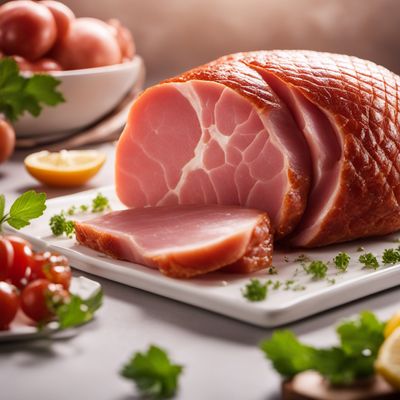
Ingredient
Corned pork, uncooked
Savory Delights: Unleashing the Flavorful Potential of Uncooked Corned Pork
Corned pork, uncooked, is a cut of pork that has been cured in a brine solution with a blend of spices, typically including coriander, peppercorns, and cloves. This curing process gives the meat a distinct flavor and a tender texture. The uncooked form of corned pork is often used in recipes that require slow cooking or braising, allowing the flavors to meld and the meat to become tender and succulent. Its appearance is characterized by a pinkish hue and marbling of fat throughout the meat.
Origins and history
The practice of corning meat, including pork, dates back centuries and was initially developed as a method of preserving meat before the advent of refrigeration. The term "corned" refers to the use of large grains of salt, known as "corns," in the curing process. Corned pork has its roots in Irish cuisine, where it became a popular dish during the 17th century. It later gained popularity in other parts of Europe and eventually made its way to various culinary traditions around the world.
Nutritional information
Corned pork, uncooked, is a good source of protein and essential vitamins and minerals. It is relatively high in calories, with approximately 250 calories per 100 grams, making it a hearty and satisfying ingredient.
Allergens
Corned pork, uncooked, may contain allergens such as sodium nitrite, which is used as a preservative in the curing process. Individuals with sensitivities or allergies to nitrites should exercise caution when consuming this ingredient.
How to select
When selecting corned pork, uncooked, look for cuts that have a good balance of lean meat and marbling. The meat should be firm to the touch and have a fresh, pinkish color. Avoid cuts that appear overly fatty or have a strong odor.
Storage recommendations
To maintain the freshness and quality of uncooked corned pork, store it in the refrigerator at a temperature below 40°F (4°C). It is best to keep it in its original packaging or wrap it tightly in plastic wrap to prevent any cross-contamination with other foods.
How to produce
Producing corned pork, uncooked, requires a curing process that involves soaking the pork in a brine solution with a blend of spices for several days. This process is best left to professionals or experienced home cooks, as it requires precise measurements and knowledge of food safety practices.
Preparation tips
Before cooking corned pork, uncooked, it is recommended to rinse it under cold water to remove excess salt from the curing process. Depending on the recipe, it can be boiled, braised, or slow-cooked to achieve a tender and flavorful result. Adding aromatic vegetables such as onions, carrots, and celery to the cooking liquid can enhance the overall taste. Corned pork, uncooked, is commonly used in dishes like corned beef and cabbage, Reuben sandwiches, or as a flavorful addition to stews and soups.
Culinary uses
Corned pork, uncooked, is commonly used in traditional Irish dishes such as corned beef and cabbage, where it is slow-cooked to perfection. It can also be sliced and used as a filling for sandwiches, added to stews or soups for added flavor, or incorporated into various regional cuisines for a unique twist.
Availability
Corned pork, uncooked, is commonly available in regions with a strong Irish or European culinary influence, such as Ireland, the United Kingdom, and parts of North America.


